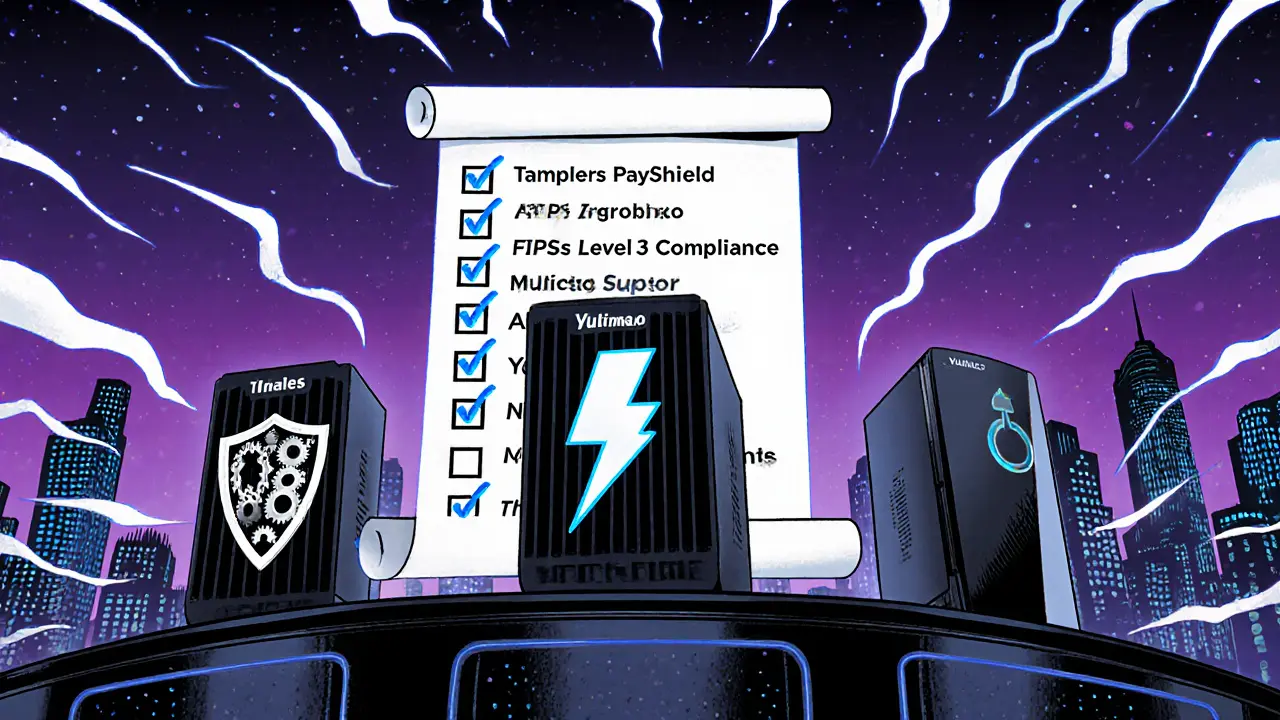Hardware Security Modules (HSM) for Cryptocurrency: What They Are and How They Protect Your Coins
HSM Security ROI Calculator
Calculate Your Security Risk
Estimate potential losses from crypto theft without proper security measures and see the value of implementing an HSM.
Security Analysis
When you hear about hacks that drain millions of crypto tokens, the first thing you wonder is: how could the private keys have been stolen? The answer often points to the environment where those keys lived. hardware security module is the answer to that problem, delivering a sealed vault for keys that never leave the device.
What is a Hardware Security Module?
Hardware Security Module is a purpose‑built, tamper‑resistant appliance that generates, stores, and uses cryptographic keys inside a protected boundary. It is also known as HSM. These devices originated in banking and government sectors, but today they are a cornerstone of Cryptocurrency security, where a private key controls access to assets permanently recorded on the blockchain.
Why HSMs matter for cryptocurrency
In the crypto world the private key is the only thing that can unlock funds. Exposing that key to a general‑purpose server or a developer’s laptop instantly creates a single point of failure. An HSM eliminates that risk by ensuring the key never leaves the secure enclave. The device performs every cryptographic operation-signing, decryption, key derivation-inside its hardened processor, so even if the host OS is compromised the attacker cannot extract the key material.
Core security features of crypto‑focused HSMs
- Tamper evidence: Any attempt to open the chassis triggers alarms or erases keys.
- Tamper resistance: The cryptoprocessor is built to survive physical attacks without revealing secrets.
- Tamper responsiveness: When a breach is detected, the module can instantly zeroize all stored keys.
- FIPS 140‑2 compliance: Most enterprise HSMs are certified to Level 3 or higher, a requirement for regulated financial institutions.
- Standard APIs: Integration is done via PKCS#11, CNG, or vendor‑specific SDKs, making it easier to plug into existing wallet software.
Compliance standards such as FIPS 140-2 ensure the module’s cryptographic boundary has been independently validated for strength and reliability.

Typical deployment models
HSMs can be deployed in several ways, each fitting a different risk profile.
- On‑premises appliance: Rack‑mount units sit in a locked data‑center cage, connected to the wallet backend via dedicated network links.
- Air‑gapped device: Standalone units that never connect to any network, used for cold storage and signing of high‑value transactions.
- Cloud HSM as a Service: Managed instances (e.g., AWS CloudHSM, Azure Dedicated HSM) that provide the same FIPS guarantees while removing the need for physical hardware maintenance.
Each model trades off convenience, cost, and trust. For institutions that must meet NYDFS or EU AML regulations, on‑prem or air‑gapped solutions are preferred. Start‑ups often begin with a cloud HSM to avoid large upfront CAPEX.
How HSMs integrate with blockchain wallets
Integration boils down to three steps:
- Provision the HSM and generate a master key pair inside it using the vendor’s management console.
- Configure the wallet software to use the PKCS#11 library that talks to the HSM. Most open‑source node implementations (e.g., Geth, Bitcoin Core) support this via a thin wrapper.
- Define signing policies-single‑signer, multi‑signer, or threshold signatures-within the HSM’s secure policy engine.
When a transaction needs to be signed, the wallet sends the hash to the HSM. The module signs it internally and returns the signature, never exposing the private key. This flow mirrors how large exchanges like Coinbase and Kraken protect their hot wallets.
Comparing HSMs with other key‑management approaches
| Option | Security level | Ease of use | Typical cost |
|---|---|---|---|
| Hardware Security Module | Highest (keys never leave hardware) | Medium - requires integration work | $50k‑$250k+ |
| Software wallet (cold storage) | Medium (key stored on encrypted disk) | High - simple UI | $0‑$100 |
| Multi‑signature (M‑of‑N) on cloud | High (requires multiple keys) | Low - complex coordination | $10k‑$100k+ |
The table shows why institutions favor HSMs: they offer a provable hardware root of trust that software solutions simply cannot match. However, the higher price and integration effort make HSMs overkill for hobbyist investors.

Choosing the right HSM: criteria and top providers
When evaluating an HSM for crypto custody, focus on these criteria:
- Algorithm support: ECDSA, EdDSA, and upcoming post‑quantum schemes.
- Blockchain SDKs: Vendor‑provided libraries for Bitcoin, Ethereum, and emerging chains.
- Scalability: Ability to cluster units for high‑throughput signing (e.g., 15ktx/s for large exchanges).
- Compliance certifications: FIPS 140‑2 Level 3+, Common Criteria EAL 4+.
- Operational costs: Maintenance contracts, firmware upgrades, and support SLA.
Among the market leaders:
- Thales - flagship PayShield series, widely used by exchanges, strong FIPS pedigree.
- Utimaco - CryptoServer line, good multi‑chain support, solid clustering options.
- Yubico - YubiHSM 2, lightweight and developer‑friendly, popular for start‑ups.
Newer niche players like Sepior and Qredo focus on HSM‑MPC hybrids, but the three above remain the safest bets for enterprises today.
Implementation checklist and best‑practice tips
Before you roll out an HSM, run through this quick checklist:
- Secure physical space - locked rack, CCTV, and restricted access.
- Generate keys inside the HSM; never import external private keys.
- Enable tamper‑response policies (zeroize on breach).
- Integrate via the standard PKCS#11 library and test with a sandbox network.
- Implement role‑based access control: separate operators, auditors, and developers.
- Set up high‑availability clustering if you need hot‑wallet availability.
- Conduct regular FIPS 140‑2 compliance audits and firmware updates.
- Document a disaster‑recovery plan - how to replace a failed HSM without losing keys.
Pro tip: start with an open‑source simulator like SoftHSM to prototype your integration, then migrate to a production‑grade appliance once the workflow is stable.
Frequently Asked Questions
Can I use a regular USB flash drive as a cheap HSM?
No. A flash drive lacks tamper detection, secure key storage, and FIPS certification, so the private key could be copied or extracted by malware.
Do cloud HSM services violate the "cold storage" principle?
Only if you keep the HSM online 24/7. Many providers offer a "bring‑your‑own‑key" mode that lets the module stay offline until a signing request arrives, preserving the cold‑storage ethos.
What is the difference between FIPS 140‑2 Level 2 and Level 3?
Level 2 adds role‑based authentication and basic tamper‑evidence. Level 3 introduces tamper‑responsiveness (zeroizing keys) and stronger physical protection, which is required for most regulated crypto custodians.
How does an HSM‑MPC hybrid improve security?
MPC splits the signing operation across multiple HSMs, so no single device holds the complete private key. Even if one module is compromised, an attacker cannot produce a valid signature.
What maintenance costs should I budget for an HSM?
Beyond the upfront hardware price, expect annual service contracts (10‑20% of purchase price), firmware updates, and occasional hardware swaps for compliance or post‑quantum upgrades.






7 Comments
Andrew Mc Adam
October 16 2025Wow, diving into HSMs can feel like stepping onto a movie set-lights, cameras, and a vault that never lets the hero’s secret key slip away. I’ve seen folks store private keys on ordinary laptops and end up with a blockbuster hack that could’ve been avoided. The tamper‑evidence feature is like a security alarm that screams “nope” the moment anyone tries to pry it open. Even if you’re a small startup, slappng a YubiHSM 2 in front of your node is a drama‑free way to keep the villains out. Remember, the key never leaves the hardware, so the only drama you’ll have is choosing which color bezel looks cooler.
Shrey Mishra
October 26 2025It is imperative to recognize that the cryptographic assurances offered by a Hardware Security Module are not merely conveniences but foundational necessities for safeguarding digital assets. The immutable nature of key confinement within the module constitutes a formidable barrier against intrusion. While the exposition is thorough, one must also contemplate the implications of supply‑chain integrity when procuring such devices. Failure to verify the provenance could, in theory, introduce latent vulnerabilities. Consequently, a diligent approach to acquisition and verification is strongly advocated.
Ken Lumberg
November 5 2025Anyone who still thinks a software wallet is “good enough” is practically inviting theft. The ethical responsibility of a custodial service is to treat users’ funds like a bank treats deposits – with the highest possible security. If you’re not using an HSM, you’re basically gambling with other people’s money. Institutions that claim to care about their clients should make HSM deployment a non‑negotiable standard. Anything less is a betrayal of trust.
John Beaver
November 15 2025Just a heads up – when you spin up a cloud HSM you’ll want to lock down the VPC and enforce IAM roles tight. Forgetting that step is a common slip that can let a rogue admin peek at the traffic. Also, keep an eye on the firmware version; vendors push patches that fix subtle side‑channel bugs. In my experience, a quick audit after the first month saved us from a nasty surprise.
EDMOND FAILL
November 26 2025Totally agree with the movie analogy, Andrew. I’ve actually set up a YubiHSM 2 with Geth and it was smoother than I expected – just a few config tweaks and the keys never left the box. The real win is that you can still fire up a testnet node locally without ever exposing the master key. It’s a solid middle ground for devs who want security without the overhead of a full‑blown rack unit.
Brian Elliot
December 6 2025One thing that often gets overlooked is the importance of role‑based access controls on the HSM itself. Even if the hardware is tamper‑proof, a careless operator could still misuse the signing function. Setting up separate accounts for auditors, operators, and developers reduces the attack surface dramatically. It’s also good practice to log every signing request for later review.
Michael Bagryantsev
December 16 2025When you think about disaster recovery, consider that the HSM can be hot‑swapped if you have a clustered setup. This means you won’t lose signing capability even if a unit fails. Pair that with a secure key‑backup strategy – for example, splitting the master key across multiple HSMs using an MPC scheme – and you’ve got resilience built right in.